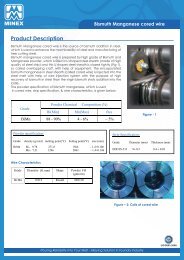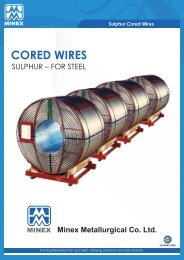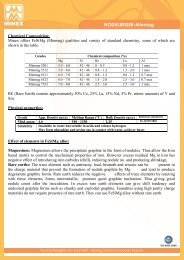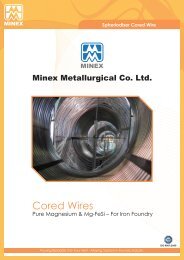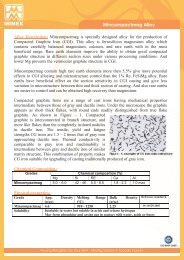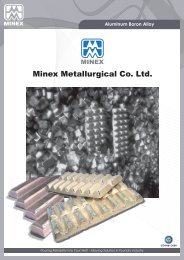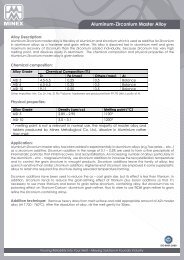Ferro silicon Zirconium ( FeSiZr ) - Minex
Ferro silicon Zirconium ( FeSiZr ) - Minex
Ferro silicon Zirconium ( FeSiZr ) - Minex
- No tags were found...
You also want an ePaper? Increase the reach of your titles
YUMPU automatically turns print PDFs into web optimized ePapers that Google loves.
<strong>Ferro</strong> <strong>silicon</strong> <strong>Zirconium</strong> ( <strong>FeSiZr</strong> )<br />
Alloy Description: <strong>Ferro</strong> Silicon <strong>Zirconium</strong> is the alloy of Iron Silicon and <strong>Zirconium</strong> produced by direct<br />
reduction of zircon sands in electric arc furnaces at high temperature. This alloy is used as <strong>Zirconium</strong> additive<br />
in steel melt, which reacts with Oxygen, Nitrogen and Sulphur. <strong>Zirconium</strong> has been used in steel making<br />
additive for over more than 40 years. But this alloy (<strong>FeSiZr</strong>) is still today the lowest cost source of Zr available as<br />
steel additive. The specification of <strong>FeSiZr</strong> supplied by <strong>Minex</strong> is given below:<br />
<strong>FeSiZr</strong><br />
Alloy Chemical Composition %<br />
Grade Zr Si Al (max) C (max) S (max) P (max) Fe<br />
18-20 18-20 45-65 1 1 0.020 0.030 Bal<br />
18-20’ 18-20 40-50 1 1 0.020 0.030 Bal<br />
30-35 30-35 43-48 1.50 0.30 0.020 0.030 Bal<br />
35-40 35-40 45-55 1 1 0.020 0.030 Bal<br />
35-40’ 35-40 40-50 1 1 0.020 0.030 Bal<br />
40-45 40-45 40-50 1 1 0.020 0.030 Bal<br />
Physical Properties:<br />
Grade Sp. Gravity (gm/cc) Melting range (°C) Chill Factor (°C)<br />
20-45 3.2 – 3.7 1250 -1350 – 8.9 1<br />
Reference Standard<br />
IS – 15396:2003<br />
*chill factors are the temperatures changes in °C of a steel bath at 1600°C after<br />
1 wt% addition of <strong>Ferro</strong> Alloys & metals at room temperature.<br />
Application and Advantages:<br />
<strong>FeSiZr</strong> is used to scavenge impurities (Oxygen, Nitrogen, Sulphur) or modify inclusion through the formation of<br />
complex sulphides and oxysulphides. ZrS is significantly more stable than MnS in steel. Therefore, if enough free<br />
zirconium is available during the early stages of solidification of a steel ingot, ZrS will form and prevent the<br />
formation of MnS. ZrS is much more refractory than MnS and practically non – deformable during hot rolling<br />
while, in aluminum killed steels, MnS produces long flat stringer inclusions in hot rolled plate and strip. The<br />
efficacy of <strong>Zirconium</strong> additions will therefore be measured not by the amount of residual “acid soluble” metal<br />
which remains, but by the extent to which inclusions are beneficially modified. It also raises the yield/tensile<br />
ratio and improves weldability through the reduction of under bead cracking and the elimination of porosity.<br />
In high alloys steels, <strong>Zirconium</strong> increases hardness but decreases ductility. In stainless steels, <strong>Zirconium</strong> retards<br />
the formation of sigma phase<br />
Pouring Reliability Into Your Melt - Alloying Solution in Foundry Industry
<strong>Ferro</strong> <strong>silicon</strong> <strong>Zirconium</strong> ( <strong>FeSiZr</strong> )<br />
Addition:<br />
When added in molten steel bath, it dissolved fast and <strong>Zirconium</strong> combines chemically with Oxygen,<br />
Nitrogen and Sulphur in the order named. The quantity of <strong>Zirconium</strong> addition per ton of steel required to<br />
improve steel properties has not been found to depend on the sulphur content as it is with Rare-Earth metal<br />
addition. Consequently, it is more economical to use <strong>Zirconium</strong> and Rare-Earth in steels with sulphur contents<br />
of 0.02% or more. Thus the amounts <strong>Zirconium</strong> to be added, depends more on the Nitrogen and Oxygen<br />
content than on Sulphur content. To be effective, the addition of <strong>Zirconium</strong> has to be sufficient to leave more<br />
free Zr after the precipitation of practically all the Nitrogen content as <strong>Zirconium</strong> Nitride and <strong>Zirconium</strong><br />
Carbonitride. The addition of <strong>Zirconium</strong> can be made in Aluminium Killed steel as:<br />
Manufacturing process % Nitrogen Minimum requirement of <strong>Zirconium</strong><br />
Of steel<br />
content % Zr Addition of <strong>Zirconium</strong> Kg/ ton<br />
BOF and OH steels 0.003 – 0.006 0.06 0.8 – 1.0<br />
Electrical Furnace steel 0.005 – 0.009 0.08 1.14 – 1.5<br />
The above table suggests that for basic oxygen steels with sulphur in the range 0.02 – 0.03, 0.8 – 1 kg of<br />
<strong>Zirconium</strong> per ton of steel is sufficient where as in electric furnace 1.2 – 1.5 kg.<br />
Usually <strong>Ferro</strong> Silicon <strong>Zirconium</strong> is added to steel in ladle, it can be also added in mould. The recovery of<br />
<strong>Zirconium</strong> depends on various factors as grade of steel, Oxygen concentration, Nitrogen & Sulphur content,<br />
time of addition etc. The recovery of Zr is found 35% to 60%. For optimum result of Zr recovery, it is<br />
recommended to add the zirconium after the Aluminum and Calcium treatment.<br />
Standard size:<br />
Std. Size (mm)<br />
Lumps 10-60 & 10-80<br />
Granules 2-5<br />
Powder 1-2, 0.30-1.50, 0.10-1.18 & Below 1<br />
Or size as per customer requirement<br />
Storage:<br />
Keep in Cool and dry places.<br />
Packing:<br />
400 Kg Steel Drum, 1MT Jumbo Bag<br />
Or as per customer requirement.<br />
Safety:<br />
Material Safety data sheet can be supplied on demand.<br />
Pouring Reliability Into Your Melt - Alloying Solution in Foundry Industry



